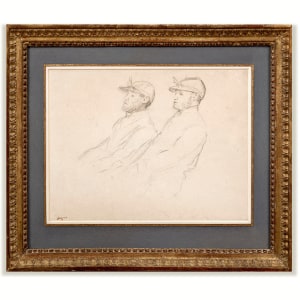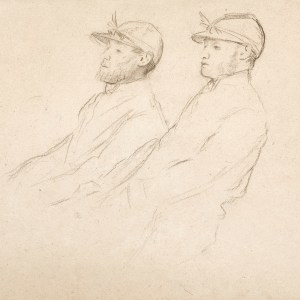The unconventional composition of this drawing, done from life—cropped tightly to the upper torsos of two jockeys and left deliberately unresolved with passages of exploratory line—reflects Degas’s determination to challenge accepted artistic conventions. The sheet is typical of his approach to equestrian art, seeking highly original compositions of fleeting moments.
Degas’s lifelong engagement with equestrian themes began in the 1860s and spanned his entire career, producing some fifty paintings and hundreds of drawings devoted to jockeys and racehorses. Rather than depicting the instant of gallop, he preferred the nervous suspension before or after a race, concentrating on the balance of the mounted rider and the interplay between horse and man.
The present sheet is a preparatory study for Degas’s celebrated Scene from the Steeplechase: The Fallen Jockey (National Gallery of Art, Washington), begun in 1866. It shows two jockeys in bust-length profile and is distinguished by its execution on blue paper, a support rarely used by Degas. A close counterpart is also preserved in Washington: the blue-paper Fallen Jockey (c. 1866), which isolates the prone rider. Taken together, these sheets clarify different aspects of the larger composition: the Washington drawing recording the fallen figure, while Deux Jockeys captures the upright mounted jockeys in conversation, anticipating the pair at the upper left of the canvas.
When The Steeplechase was later purchased by Alexander Cassatt, brother of Mary Cassatt, Degas undertook extensive revisions in the early 1880s. That campaign, focused chiefly on the horses, is represented by the oil-interior Studio Interior with “The Steeplechase” (c. 1881, Israel Museum) and by Racehorses (study for “Scene from the Steeplechase”), c. 1881 (NGA Washington). By contrast, Deux Jockeys belongs securely to the painting’s original 1860s conception. Its exploratory line, touches of brown chalk, and rare blue-paper support point firmly to this earlier phase, before Degas returned to the composition some fifteen years later.
Like many of his racing studies, Deux Jockeys exemplifies Degas’s method of isolating figures to refine posture and gesture before orchestrating them into more complex painted arrangements. He frequently returned to earlier sheets, reusing them years later as sources for new compositions. This practice is most clearly demonstrated by the major reworking of The Steeplechase in the early 1880s, following its purchase by Alexander Cassatt, when Degas drew on several fresh studies of horses — such as Racehorses (study for “Scene from the Steeplechase”), c. 1881 (NGA Washington) — to revise the composition. The same process of re-appropriation can be seen in Jockeys Before the Race (Barber Institute of Fine Arts, Birmingham), shown at the Fourth Impressionist Exhibition in 1879, where the tightly cropped jockey motif strongly recalls the present drawing.
This tendency to reuse and rework can make dating difficult, yet there is a strong argument for placing Deux Jockeys firmly among Degas’s earliest equestrian works of the 1860s. Its exploratory style, rare blue-paper support, and direct link to the original conception of Scene from the Steeplechase: The Fallen Jockey distinguish it as an exceptionally early and rare survival connected to one of the artist’s greatest paintings.
Provenance
The artist’s estate;His Sale: Galerie Georges Petit, Paris, April 1919, lot 141;
Private collection, France, by descent until 2024
Publications
Galerie Georges Petit, Atelier Edgar Degas, 3rd sale , April 7-8-9, 1919, lot 141Jean Sutherland Boggs et al., Degas at the Races (Washington, D.C.: National Gallery of Art; New Haven: Yale University Press, 1998), p. 123, fig. 70.



